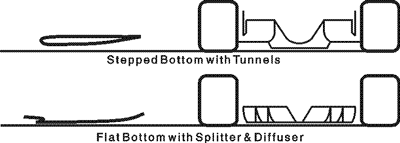INSIDE
RACING
T E C H N O L O G Y
IRT Home
IRT Home
News Page
Contents Page
Newsletter &
Books
email Paul
The Underwing and Diffuser
This is an excerpt from Inside Racing Technology.
The Underwing

Here is an underwing cross section for reference and two sketches showing cross section shapes and rear views of a tunnel car and a flat-bottom car with diffuser. Indy car sidepods and '95 Formula 1 flat bottoms have 2 inches ground clearance because the rules mandate the bottom of the sidepod at 2 inches above the bottom of the car.

The lower sketch shows an underwing similar to that of a current Indy Lights car and that of an F1 car prior to the "plank rule" created in mid-1994. It's a flat plane starting with a "splitter" and ending in a diffuser section. The splitter is a lip at the front of the underwing that causes a clear division of air going under the car and air going around the car. Maximum downforce demands minimum ground clearance for the splitter and a specific "rake" of the flat part of the underwing.

The Diffuser
The purpose of the diffuser is to allow the air that has been accelerated (so that its higher speed can produce a lower pressure) under the car to decelerate back to close to the same speed and pressure it was before the car ran into it. The better the diffuser works, the less drag the underwing produces.
You also see lateral fences or strakes in the diffuser area at the rear of the car. These have been banned from Indy cars (that means they worked), but Indy Lights and F1 cars still use them. The strakes probably do several things, but one of the most obvious is that they prevent low-speed, high-pressure air getting in along the sides of the car from disturbing the flow in the central area of the diffuser.